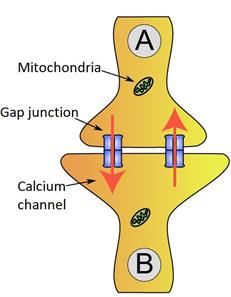PDF chapter test TRY NOW
The term "synapse" was coined by physiologist Michael Foster in his "Textbook of Physiology" in 1897, and it is derived from the Greek word "synapsis", which means "conjunction." The term synapse is the meaning of “coming together.”
A synapse is a small gap present at the end of a neuron that permits a signal to travel from one neuron to the next. The sites where nerve cells communicate with one another are known as synapses.
There are two types of synapses:
- Electrical synapses
- Chemical synapses
Information is exchanged at chemical synapses by one neuron releasing a neurotransmitter and another neuron detecting the neurotransmitter, whereas, at electrical synapses, the cytoplasm of adjacent cells is directly joined by clusters of intercellular channels called gap junctions.
Now, let us look at the different types of synapses using visual representations.
1. Conduction of nerve impulse through an electrical synapse:
Electrical synapses have a very different mode of neurotransmission than chemical synapses. In an electrical synapse, the presynaptic and postsynaptic membranes are relatively close together. These synapses allow electrical current to travel straight from one neuron to the next.
A structural and electrically conductive link is formed between two neighbouring neurons at a gap junction: a tiny gap between the pre and postsynaptic neurons. Current can flow directly from one cell to the next through gap junctions.
In addition to the ions that transport the current, other molecules, such as ATP, can also pass through the wide gap junction pores. Electrical synapses are rare in our system.

Electrical synapsis
2. Conduction of nerve impulse through a chemical synapse:
Henry Dale discovered the method of chemical transmission across synapses in 1936. He was awarded the Nobel prize along with Otto Loewi for their research on chemical synaptic transmission.

The chemical synapse between two neurons
1. In the chemical synapse, the membranes of the pre and postsynaptic neurons are separated by a fluid-filled gap called the synaptic cleft. The transmission of impulses at synapses is facilitated by chemicals known as neurotransmitters. Neurotransmitters transmit information from a presynaptic sending neuron to a postsynaptic receiving neuron.
2. Vesicles containing neurotransmitters are seen in the axon terminals of the neuron. Neurotransmitters can be either excitatory, E.g. Acetylcholine or inhibitory, E.g. GABA (Gamma-aminobutyric acid). Acetylcholine and noradrenaline are the two major neurotransmitters in the nervous system of invertebrates.
3. A nerve impulse activates voltage-gated calcium channels in the cell membrane as it reaches the axon terminal. Calcium ions, which are considerably more abundant outside the neuron than inside, rush into the cell.
4. The calcium ions cause the synaptic vesicles to move to the knob's surface. Synaptic vesicles then fuse with the axon terminal membrane, allowing the neurotransmitter to enter the synaptic cleft. The synaptic vesicles then return to the synaptic knob's cytoplasm to be refilled with neurotransmitters.
5. The release neurotransmitters bind to receptors on the postsynaptic membrane. The activation of postsynaptic receptors causes ion channels in the cell membrane to open or close. The newly created potential could be either excitatory or inhibitory. The transmission of impulses over an electrical synapse is faster than the transmission of impulses across a chemical synapse, as we have shown.
Important!
Each neuron can transmit 1,000 nerve impulses per second and make as many as ten thousand synaptic contacts with other neurons.
Conduction nerve impulses
Reference:
https://commons.wikimedia.org/wiki/File:Synapse_Illustration2_tweaked.svg
https://commons.wikimedia.org/wiki/File:Synapse_diag2.png
